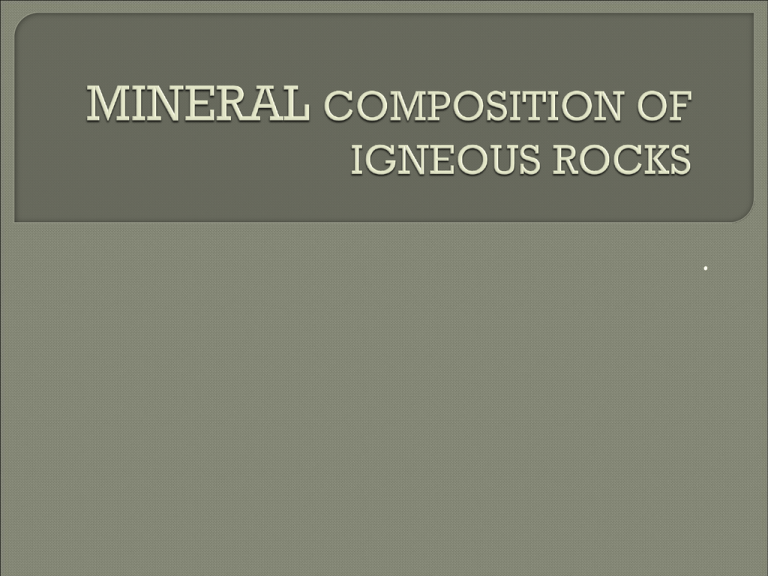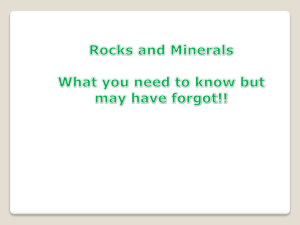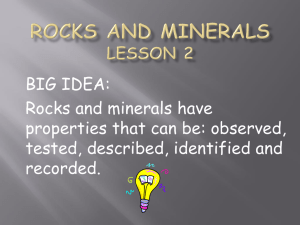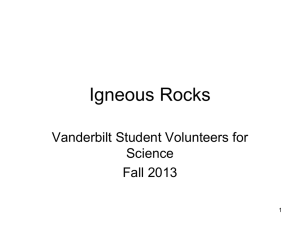MINERAL COMPOSITION OF IGNEOUS ROCKS
advertisement

. ROCKS All rocks are made of 2 or more minerals, but minerals are not made of rocks. Rock Words: There are many common names for rocks and the usually give you an idea of how big the rock is. Here are a few: mountain - huge, giant hunk of rock that is still attached to the earth's crust, doesn't move, tall boulder - large, taller than a person ROCKS All rocks are made of 2 or more minerals, but minerals are not made of rocks. Rock Words: rock - large, you could get your arms around it or a bit smaller but it is usually jagged, broken off a bigger piece of rock river rock - round rocks that are along the edge & at the bottom of fast-flowing rivers stone - medium, you could hold it in two hands ROCKS pebble - small, you can hold it with two fingers, could get stuck in your shoe, usually rounded sand - made up of tiny pieces of rock, grains of sand grain - tiny, like a grain of rice or smaller, often found on a beach dust - really fine powder that is mixed in with sand or soil speck - as in a speck of dirt MINERALS A mineral is the same all the way through. That is one reason we speak of a sample or a specimen rather than a rock. There are about 3000 known minerals on earth. All rocks are made up of 2 or more of these minerals Gabbro is a dark-colored coarse-grained intrusive igneous rock. The specimen shown above is about two inches (five centimeters) across. This table describes the composition of igneous rocks Igneous rocks are rocks which solidify from molten material (magma). Cooling of the magma can occur beneath the surface (intrusive) or on the surface (extrusive). Igneous rocks can be identified by the determination of the composition and texture of the rock. Igneous Rock Identification Chart COMPOSITION TEXTURE Felsic Intermediate Mafic Pegmatitic Granite Pegmatite Diorite Pegmatite Gabbro Pegmatite Phaneritic Granite Diorite Gabbro Aphanitic Rhyolite Andesite Basalt Porphyritic Rhyolite Andesite Basalt Glassy Obsidian Basaltic Glass Vesicular Pumice Scoria Pyroclastic Volcanic Tuff Ultramafic Dunite Color is often an indicator of the composition of a rock or mineral and can be effectively used to identify the composition of most igneous rocks. Light colors, including white, light gray, tan and pink, indicate a felsic composition. Felsic compositions are rich in silica (SiO2). Dark colors, such as black and dark brown, indicate amafic or ultramafic composition. Mafic compositions are poor in silica, but rich in iron (Fe) and magnesium (Mg). Intermediate compositions have an intermediate color, often gray or consisting of equal parts of dark and light mineral . Beware that even though an igneous rock may have a felsiccomposition (light color), the rock can contain dark colored minerals. Mafic rocks may contain light colored minerals as well. As mentioned above, the composition of most igneous rocks can be identified using this system, formally known as the Color Index. However, there are exceptions. The two most notable are obsidian and dunite. Obsidian is volcanic glass which erupts as a lava flow. Most obsidian is felsic in composition, yet typically it will have a very dark color (dark brown to black). Dunite has an ultramafic composition yet is apple green to yellowish green in color. Dunite is composed almost entirely of the mineral olivine which usually contains both iron and magnesium. Practice Identifying Igneous Rocks http://facweb.bhc.edu/academics/science/harwoodr/geol101/Labs/I gneous/Igsamp01.htm Answer at least Five Define • • • • • • • Magma Lava Extrusive Igneous Rocks Intrusive Igneous Rocks Streak Moh’s Scale The difference between a rock and mineral. Answer at least Five Write a list of at least five ways to Identify rocks and mineral samples. Which has the largest crystal texture? • Porphyritic or Pegmatitic What is the name to describe an extrusive rock’s holey outer texture on a rock such as pumice? This chart explains what Igneous Rocks are made of and some common vocabulary words associated with igneous rocks Here's something for you to think about: List the percentag es of minerals found in rock 'Z'!" According to the chart, what's the maximum number of minerals that can occur together in one igneous rock? Can an igneous rock consist of just one mineral? What are the names of three minerals that do not occur together in the same rock with pyroxene? Why use luminescent rocks in a driveway? • Their glow lasts for 10 – 20 hrs. 1.Write the five names of the minerals in Rock X. 2.Circle the mineral that has the highest percentage in Rock X. 3. Explain why Olivine is at the top of the left side of this chart and Quartz appears at the bottom?










